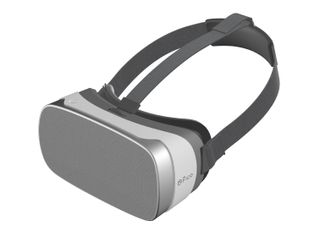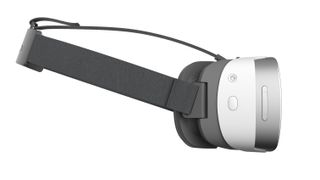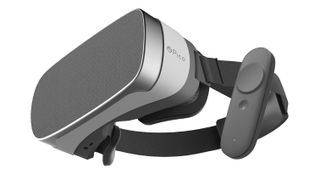Standalone VR On A Budget: Pico's 'Goblin' HMD

Pico Interactive’s Goblin is an Android-based VR headset with 3DoF tracking, a 2.5K display, and a companion motion controller for under $300. That may seem like a lot when compared to a less expensive Gear VR or Daydream headset, but with the Goblin, you don’t need a $1,000 smartphone to power it. Everything is built right into the headset.
The VR industry is transitioning away from treating mobile VR as a smartphone accessory and moving towards treating mobile VR as another category of consumer electronic. The race for standalone VR headsets is well underway, and we’ll soon have access to a smattering of VR HMD choices that feature onboard processing and storage and don’t rely on a companion smartphone.

Most of the big players in VR are pursuing standalone headsets of one form or another. Last August, Intel revealed the Project Alloy “merged reality” HMD and got the standalone VR bandwagon rolling. In September, Qualcomm announced the Snapdragon VR820 SoC, which it designed for standalone VR headsets. The Snapdragon VR820 processor was the first clear sign that the VR hardware industry was making moves towards self-contained HMDs. A month later, at the Oculus Connect 3 conference, Oculus showed off a standalone headset prototype based on the Rift. That product won’t see the light of day for a while, but that reveal somewhat set the tone in the industry and the pace started to pick up from there. We’ve since heard announcements from HTC about a standalone Vive headset, and Google launched a standalone Daydream HMD reference design at Google I/O.
Now, a little-known company called Pico Interactive is joining the big players at the table with its own offering. And Pico even beat the big dogs to the punch (likely thanks to Qualcomm’s VR HMD Accelerator program). Pico Interactive announced that pre-orders are now open for the company’s Goblin VR HMD, which it plans to start shipping to customers in 6 to 8 weeks.
“One of the biggest pain points for consumers interested in virtual reality headsets is the high cost of entry,” said Paul Viglienzone, vice president of business development, Pico Interactive Inc. ”We believe the price point of the Pico Goblin solves this issue for casual gamers, families and many tech enthusiasts. With its all-in-one wireless design, the range of great games, and ultra-portability, the Pico Goblin aims to shake up the VR world this summer.”
Pico Interactive positioned the Goblin as an entry-level Android-based VR HMD for people on a medium budget. The Goblin HMD features a Snapdragon 820 SoC, 3GB of memory, and 16GB of storage. It also features a 5.5-inch 2560x1440 display that operates at 70Hz. Pico also includes a 3DoF motion controller like you would find with a Daydream HMD. Those are pretty good specifications for mobile VR. To put it into perspective, the Samsung Galaxy S7, which is an excellent companion to the Gear VR, features a Snapdragon 820 SoC, 4GB of memory and a screen with the same resolution. The difference here is that Galaxy S7 would have set you back $600 a year ago, plus you would need at $99 Gear VR. By comparison, the Pico Interactive Goblin is $269, and you don’t need anything else with it.

Pico Interactive is even sweetening the pot for pre-order customers. The company is offering a $20 discount and “five premium VR games” to anyone who orders a kit before its release this summer. Pico didn’t say which games come with the headset, but the company said there would be 50 titles ready to go on launch day.
Stay on the Cutting Edge
Join the experts who read Tom's Hardware for the inside track on enthusiast PC tech news — and have for over 25 years. We'll send breaking news and in-depth reviews of CPUs, GPUs, AI, maker hardware and more straight to your inbox.
For more information about the Pico Goblin, or to place an order, head over to Pico Interactive’s website. The company is also developing a premium standalone headset called the Pico Neo, but that hardware isn’t on sale yet.
| Processor | Qualcomm Snapdragon 820, 2.2GHz 64-bit quad core, Adreno 530 GPU, Hexagon 680 DSP |
|---|---|
| Display | 5.5" Super Fast TFT LCD, 2560 x 1440 70Hz |
| Optical | Self-adaptive pupil distance (54-71mm), 92-degree FOV, blue ray reduction |
| Memory | 3GB LPDDR4-1866 |
| Storage | 16GB eMMC 5.1 SSD, support for up to 128GB MicroSD |
| Sensors | 3DoF IMU with 1000Hz sample rate, proximity sensor to enable sleep mode |
| Audio | 3.5mm stereo earphone jack, mono speaker, microphone |
| Battery | 3500mAh battery - 3-hours continuous use, support Qualcomm Quick Charge |
| Wireless | Wifi 802.11 a/b/g/n, Bluetooth 4.2 |
| Dimensions (W x L x D) | 102 x 186 x 103mm |
Kevin Carbotte is a contributing writer for Tom's Hardware who primarily covers VR and AR hardware. He has been writing for us for more than four years.
-
bit_user Wait, so this isn't a Daydream HMD? If they're trying to launch their own VR platform, well I can't see how that could possibly fail...Reply -
darth_adversor Unless I'm missing something, it's not a completely independent platform, it's Android (which is also why, I assume, there's no mention of Windows).Reply
I like the idea of a standalone VR unit. I might pick one up for my son, if the reviews are generally favorable. -
bit_user Reply
Yeah, I saw that but opted not to update my post because my basic point stands: if it's not Daydream, then every app must be written to whatever proprietary API they're using. So, you're limiting yourself to apps written specifically for it.19813644 said:Unless I'm missing something, it's not a completely independent platform, it's Android (which is also why, I assume, there's no mention of Windows).
I like the idea of a standalone VR unit. I might pick one up for my son, if the reviews are generally favorable.
Unless/until they support the Daydream APIs, that is. I wouldn't touch it, otherwise, as it would be a dead end.
If you want a standalone HMD, your best bet would be to wait until Lenovo's standalone Daydream HMD hits the market.
-
Joe Black I saw this. It's nice, but honestly I do not consider VR without 6dof to be VR. More like something between the old 3D TVs and VR.Reply
Somebody seriously needs to come up with an affordable 6dof tracking system and act as a supplier to generic VR HMD manufacturers. So that they can come up with integrated and optional extra solutions for their products.
Right now the visual fidelity is not nearly as important as good 6dof. And right now it's only available as proprietary solutions from HTC, Oculus and Sony. -
Malicex64 I talked to these guys at their E3 booth yesterday. Everything that is going to be available for it is being developed in house, and using their own Eco-system. I wouldn't touch this thing with a 10-foot pole unless they have managed to get some super rockstar geniuses that are going to put out better titles than all of the other open systems (hint, they won't)Reply -
bit_user Reply
Google! Seriously, Google/Lenovo's new Daydream HMD has 6-DoF tracking. They call it "WorldSense", because it not only tracks your location within a room, but actually at world scale:19814782 said:I saw this. It's nice, but honestly I do not consider VR without 6dof to be VR. More like something between the old 3D TVs and VR.
Somebody seriously needs to come up with an affordable 6dof tracking system and act as a supplier to generic VR HMD manufacturers.
http://www.tomshardware.com/news/google-daydream-vr-standalone-qualcomm-snapdragon-835-vr,34439.html
-
bit_user Reply
I'm guessing their plan B, which they'll probably activate way too late, is to add Daydream support for it. But if it lacks the sensors needed for 6-DoF tracking, then it'll lose out to Lenovo's Daydream HMD.19815761 said:Everything that is going to be available for it is being developed in house, and using their own Eco-system.
But even if they had the first Daydream HMD on the market, they still risk losing to Lenovo and other big players. Without hardware that has some truly unique features (and it sounds like theirs is basically just the Qualcomm reference design), it's hard to see how a small startup can hope to compete in this market.
Most Popular



